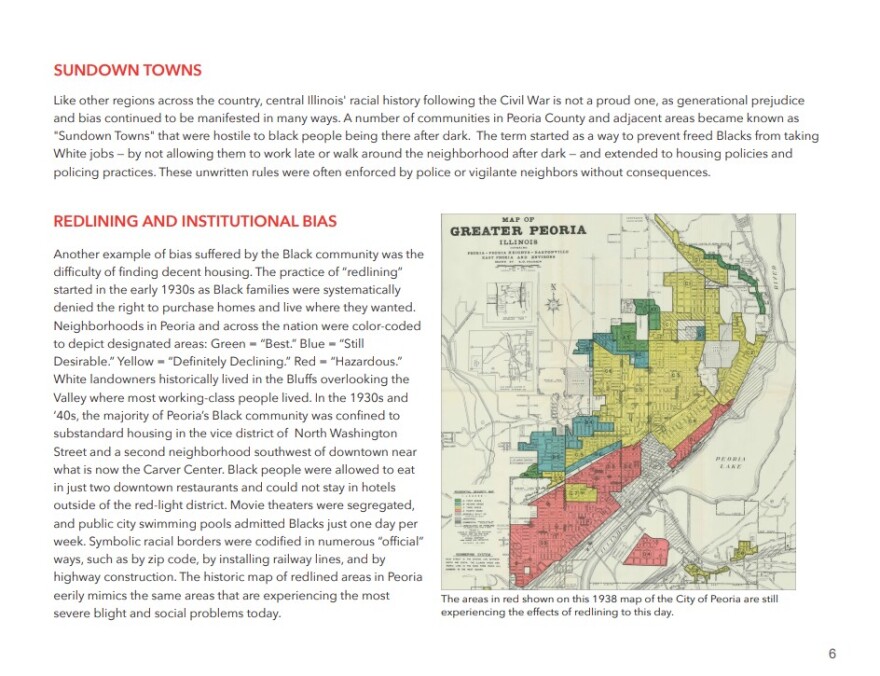The Joint Commission on Racial Justice and Equity completed and released a 30-page report documenting racial inequities in the county this week.
The commission started in October 2020, created by an agreement between the Peoria City Council and the Peoria County Board. Its first meeting was in July 2021; it now has 150 members from across the county.
Co-chairs Timothy Bertschy and Mary Peterson said the commission spent the last year and a half creating eight sub-committees, and collecting and interpreting county data from a variety of sources to set a “baseline” for racial disparities in the county.
It started with the question: “Is there racial disparity here in our community?”
“Yes, there is racial disparities in our community, and the gap is large,” said Peterson. “People of color lag behind our white counterparts in not only the county, but in the City of Peoria. And these differences make major life-changing and altering challenges for our community members.”

The report covers child and youth development, economic development and jobs, environment and climate, health and human services, housing, information and technology, the justice system and transportation and mobility.
Dozens of statistics throughout the report demonstrate disparities, but the commission loads a few at the front of the report as examples:
- 47% of Black households and 23% of Hispanic households receive food assistance, compared with 14% of white households.
- The median age for accident, injury, or death for white people in the county is 59.5 years, compared to 28 years for Black people.
- The median house value is $76,400 for Black households, while it’s $96,800 for Hispanic and $130,000 for white homes.
- Overall life expectancy is 79 years for white residents of Peoria County and 64 years for Black residents.
- Elevated lead levels are present in 6.3% of white children and 10.1% of Black children.
The report also provides some of the factors that led to these statistics, sharing information about sundown towns, redlining and institutional bias historically present in Peoria County.
“Books have been written about this, right?” said Bertschy. “I think most people know why we’re here and how we got here.”
Bertschy said the data is limited in some of the areas in the report, as well as for the Hispanic community in general. However, the commission plans to include recommendations for better data collection in their ongoing work. In areas like transportation and information technology, where data sorted by race is limited, the commission compared predominantly Black zip codes like 61602, 61603 and 61605, to primarily white zip codes.

Bertschy pointed out that metrics like student access to the internet will need to be tracked moving forward.
“I don't know how we're gonna get that data. We've talked a little bit about it,” he said. “But just to determine our success going forward, we're going to need to get data of that type.”
The co-chairs said the report constitutes the end of the first phase of the commission’s work plan. The next step is developing a strategic action plan. Peterson said this phase includes interviewing community members, staging town hall meetings and having extensive conversations with county organizations to develop solutions to the problems demonstrated by the data.
“So we're looking at that now,” she said. “How do we make the best of those forms, those town halls that we're planning to do, so that we can get the most information for our various committees.”
When asked what makes the commission’s work different than pre-existing work by nonprofits or previous efforts to further equity in the county, Bertschy said the group is working to win hearts and minds and set realistic expectations for any resulting programs.
“We believe we can make progress on this issue,” he said. “Is it going to happen next year? No. Is it going to happen two years from now? Well, maybe we can begin to make progress as we move forward. But to think that boy, things are going to change in November of 2023, would be foolish of all of us.”
Peterson said the commission also will be careful in the way it conducts interviews and uses the collected data.
“We're not going into those communities and saying, this is what happened,” she said. “We're going to work with organizations that already have the trust of those communities to be our mouthpiece for us.”
The forums and community meetings are expected to start sometime this summer and the co-chairs said the commission will provide a progress update by the end of the year, likely in December. You can find the full report here.


